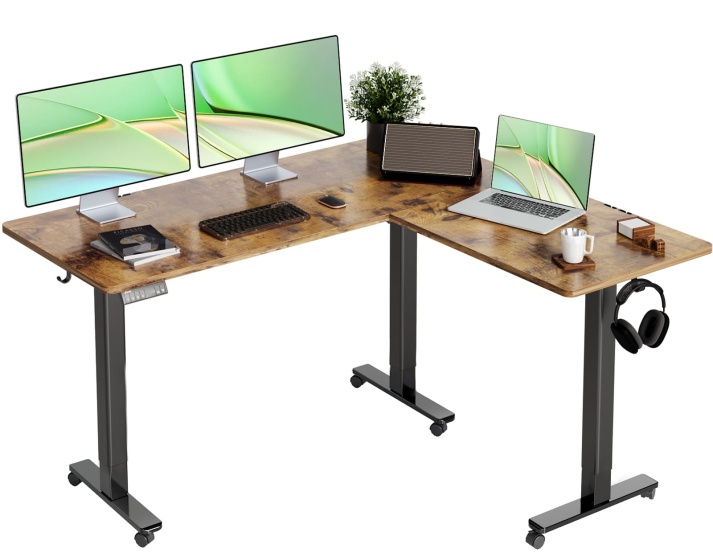Unlock Your Productivity: Discover the Game-Changing Magic of Standing Desks!
As we navigate the evolving landscape of the modern workplace, one piece of furniture has gained significant attention: the standing desk. With increasing awareness of the adverse effects of prolonged sitting, many professionals are turning to standing desks as a compelling alternative. These innovative workstations not only promote a healthier work environment but also enhance productivity and overall well-being. In a world where time is of the essence and efficiency is paramount, standing desks present an exciting opportunity to transform the way we work. Let’s explore how incorporating a standing desk into your daily routine can lead to a more energetic and productive workday.

The Benefits of Standing Desks
The advantages of using standing desks are becoming increasingly evident, supported by a growing body of research. One of the primary benefits is improved posture. Unlike traditional desks that encourage slouching, standing desks promote a more natural alignment of the spine, reducing the risk of back pain. A friend of mine, who switched to a standing desk after struggling with chronic back issues, noticed a remarkable improvement in her posture and overall comfort levels. Additionally, standing desks can help mitigate the risk of weight gain. Studies have shown that standing burns more calories than sitting, which can be particularly beneficial for those looking to maintain or lose weight. Furthermore, standing desks have been associated with enhanced mood and energy levels. A survey of users revealed that many experienced increased alertness and reduced feelings of fatigue throughout the day. This boost in mental clarity can directly translate into heightened productivity, making standing desks a worthwhile investment for anyone seeking to improve their work performance.
Types of Standing Desks
When considering a standing desk, it's essential to understand the different types available to suit various needs and preferences. Adjustable desks are among the most popular options, offering users the flexibility to change the desk height with ease. This adaptability allows users to switch between sitting and standing positions throughout the day, promoting movement and reducing fatigue. Fixed-height desks, on the other hand, are designed to stay at one height, catering to those who prefer a consistent standing experience. Convertible desks combine the best of both worlds, allowing users to transition seamlessly from sitting to standing. My colleague recently purchased a convertible desk, and she loves the fact that she can alternate between positions based on her workload and energy levels. Additionally, some standing desks come with built-in features, such as integrated cable management and storage solutions, making them a practical choice for a tidy and organized workspace.
Features to Consider When Choosing a Standing Desk
Choosing the right standing desk involves considering several key features that can significantly impact your experience. Height adjustment mechanisms are crucial; ensure that the desk can be easily adjusted to accommodate your height for optimal comfort. A desk with a broad surface area is also important, as it provides ample space for your computer, documents, and other necessary items. Stability is another vital factor; a sturdy desk will prevent wobbling, ensuring that your workspace remains functional and safe during use. Additional accessories, such as keyboard trays and monitor stands, can enhance ergonomics and promote a healthier setup. A friend of mine invested in a monitor stand to raise her screen to eye level, significantly reducing neck strain. Lastly, consider the desk's materials and aesthetics; a desk that complements your home or office decor can make your workspace more inviting and enjoyable.
Ergonomic Considerations
When utilizing a standing desk, ergonomics should be a top priority to prevent strain and discomfort. It's essential to set your monitor at eye level to avoid neck strain; your eyes should be aligned with the top third of the screen. Your elbows should be at a 90-degree angle when typing, with your wrists in a neutral position. This setup allows for a comfortable typing experience and minimizes the risk of repetitive strain injuries. Furthermore, wearing supportive footwear can also contribute to a more comfortable standing experience, reducing fatigue in your legs and feet. If you're new to standing while working, start slowly; gradually increase your standing time each day to allow your body to adapt.
Maximizing Your Work Experience with Standing Desks
In summary, the shift towards standing desks represents a significant evolution in workplace ergonomics and productivity. The numerous benefits, including improved posture, reduced risk of weight gain, and enhanced mood and energy levels, make them an appealing option for anyone looking to optimize their work environment. With various types of standing desks available, alongside essential features to consider, there is a perfect desk for everyone. By prioritizing ergonomics and making thoughtful choices about your workspace, you can harness the transformative power of standing desks to elevate your productivity and overall well-being. So, whether you're working from home or in an office, contemplate integrating a standing desk into your daily routine for a healthier, more dynamic work experience.












Comments